 s the bell shrieks the end of another school day, hundreds of
students issue forth from hallowed classrooms into corridors and
then out on to the streets, or on to the playing field, or into
the library. But there would always be that handful of boys -
calling themselves Scouts - who chart their course towards the
haven reserved for their fellowship. A hideout that haven is not,
for its location is common knowledge. Yet, once inside, the Scouts
are shielded from public scrutiny. An army mess it does not purport
to be, as strict rules govern food, beverages and entertainment.
Yet the haven as a general hangout is in fact derived from the idea
of an army mess. So indefinable that haven is - such is the
fascinating character of the V.I. Scout Den.
s the bell shrieks the end of another school day, hundreds of
students issue forth from hallowed classrooms into corridors and
then out on to the streets, or on to the playing field, or into
the library. But there would always be that handful of boys -
calling themselves Scouts - who chart their course towards the
haven reserved for their fellowship. A hideout that haven is not,
for its location is common knowledge. Yet, once inside, the Scouts
are shielded from public scrutiny. An army mess it does not purport
to be, as strict rules govern food, beverages and entertainment.
Yet the haven as a general hangout is in fact derived from the idea
of an army mess. So indefinable that haven is - such is the
fascinating character of the V.I. Scout Den.
No evidence exists today to indicate whether there was a Scout Den or Room in the old V.I. on High Street. Presumably, given the fledgling status of the Scout movement then, there probably was none. They were so short of space that even the second V.I. Headmaster, Mr R.J.H. Sidney, had to use his bedroom as an office! This could explain the excitement expressed in the 1929 Scout Notes, when a room in the spanking new V.I. on Petaling Hill was given to the Scouts for their use:
The Scouts have now a room of their own in the school. Here, a ping-pong table is provided for their use. Corners have been allotted in it to patrols and the room is being suitably decorated.
Their Room was the furthest room on the upper level
of the V.I. wing nearest the swimming pool. Ever-resourceful and full
of initiative, the Scouts did not take long to ensure the room was not
only inhabitable, but also enticing for a general hangout. By December
1930, it was well-stocked with
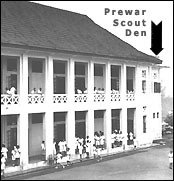 furniture and Scouting equipment. There was a carpenter's bench,
tools and wood, with a fine library of Scoutcraft books. Mindful
of the importance of camping, the Scouts also kept a first rate
double four Gilwell Tent, all the necessary pots, pans, kitbags and
other accessories for the activity. There was even a piano in the
room! A certain Mr Reeve was noted to have been providing the
accompaniment to the singing of sea shanties and Scout songs.
furniture and Scouting equipment. There was a carpenter's bench,
tools and wood, with a fine library of Scoutcraft books. Mindful
of the importance of camping, the Scouts also kept a first rate
double four Gilwell Tent, all the necessary pots, pans, kitbags and
other accessories for the activity. There was even a piano in the
room! A certain Mr Reeve was noted to have been providing the
accompaniment to the singing of sea shanties and Scout songs.
Integral to any Scout Room are the patrol corners. The First Selangor Troop patrols enthusiastically adorned their corners and as a result, the 1930 Scout Notes record that "patrol corners have been taking shape". Ideas for the patrol corners must have come, at least in part, from Scout publications such as "Gilcraft". The author of the 1930 Scout Notes, Y.B.T. reproduces an article on patrol corners from that publication. It offers some insight to us today as to what ideas might have inspired the Scouts of 1930 in the way they arranged their patrol corners:
In place of screens, swinging rods, carrying curtains made even of sacking which can be painted or decorated, are useful. The patrol concerned is to decorate the inside of its particular compartment as it desires. If the patrol specialises in any particular subject, that might be illustrated by diagrams, descriptions, pictures and examples. Some kind of a record board for the patrol, a picture of the patrol animal or bird may also adorn the walls. Frame picture work is, however, liable to be broken.
The question of seats is of some importance. It is advisable to avoid ordinary chairs and benches which are apt to take up a great deal of room and to get broken in a game. Some troops have managed to acquire log seats for each member of the troop. Other troops have made use of margarine boxes painted in patrol colours. Some troops have combined boxes for gear with seats, each patrol having a box in its corner for patrol gear which also serves as the PL's seat. Rope handles fixed to the ends of such boxes made them more easily portable. A knotting board with the Tenderfoots and other knots displayed at various stages of their make-up is an interesting exhibit. Model bridges, diagrams of bridges, outline of trees, collections of plaster casts, impressions of leaves, Scout posters and pictures, samples of timber, mementoes of expeditions, maps of the areas of different scales, are all useful possessions.
This room was probably used continuously until
the Japanese occupied Malaya. As a result of the war, it was most
probably looted and left bare or at least dilapidated, which led
the 1946 Scout Notes to declare that "the Scout Room - the work
of fifteen years, has been ruined". But the Scouts were not to
be left in the lurch for long. On 20 January 1949, the school approved
their use of the former Cadet Armoury
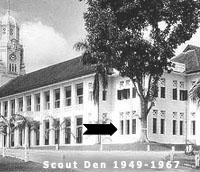 (on the corner of the School near the side entrance) as the new Scout
Room. Upon entering the room, one turned left into the area of First
KL or headed right towards Second KL's domain. As Kuan Beng Teik
(V.I. 1957-1963) remembers the Second KL side of the Room: "Each
patrol had a cubicle where there was a box to keep the treasures of
the Patrol. There were 4 Scout Patrols and 2 Senior Scout Patrols
and there was a big box to store the property of the Troop".
Aesthetics were left to the Scouts, who took pride in decorating and
maintaining the cleanliness of the Room.
(on the corner of the School near the side entrance) as the new Scout
Room. Upon entering the room, one turned left into the area of First
KL or headed right towards Second KL's domain. As Kuan Beng Teik
(V.I. 1957-1963) remembers the Second KL side of the Room: "Each
patrol had a cubicle where there was a box to keep the treasures of
the Patrol. There were 4 Scout Patrols and 2 Senior Scout Patrols
and there was a big box to store the property of the Troop".
Aesthetics were left to the Scouts, who took pride in decorating and
maintaining the cleanliness of the Room.
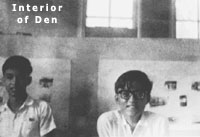
Before one gets the impression that the Scout Room was the centre of the universe for the scouts, around which their entire lives fanatically revolved, (in other words, they had no other life!) this recollection by Koh Tong Bak (V.I. 1956-1962) is useful. He notes that "the guys who lived far from the school usually hung around the Den, using the room as their base" while those who lived near the School, such as on Imbi Road or the Bukit Bintang area, and could bicycle to and from school quite easily, did not do so. In short, the devotion towards their Room was a measured one. If one peeped in while the Room was still a Scout Room, one would see the Scouts doing their homework there, patrol meetings in progress, Tenderfoots and other Scouts learning Scoutcraft like knots and Kim s Game (a game that requires the memorisation of objects within a given time limit).
In 1967, with a burgeoning school population, the
Scout Room was taken over by a sixth form class and the Scouts were
moved to the former Jaga's Hut, on the field and directly opposite the
V.I.O.B.A. building. Today, only a concrete slab on the ground and a
small heap of broken stone steps serve as a reminder of the structure
that was once there. Useful as it was, the Jaga's Hut was never intended
to be a permanent home for the Scouts. As early as the 1960's, the
Scouts were seriously talking
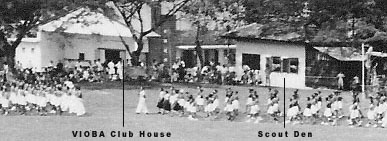 about constructing a purpose-built Den for their use, but the lack of
funds at that time was the major constraint. So the Jaga's Hut was made
a temporary haven.
about constructing a purpose-built Den for their use, but the lack of
funds at that time was the major constraint. So the Jaga's Hut was made
a temporary haven.
Many of the early steps were initiated by the former Scouts of the school, such as those who had become Rovers with the 70th KL Scout Group. Various fund-raising projects were undertaken. For instance, in August 1971, the First KL Rovers held a fund-raising Ball with the Second KL Seniors. In fact, as Koh Tong Bak recalls, the earliest traceable plans to construct a separate and permanent Scout Den date back to the early 1960's. The First KL Choir performance, under Mr Joe Howard (a Peace Corps volunteer) on television in 1964 and their Gang Show at the Chin Woo Auditorium were geared for this purpose. It was such dogged diligence by the Scouts and the ex-Scouts that eventually motivated the school administration to undertake official action for a permanent Scout Den. This was particularly reflected in a school-wide fund-raising campaign coordinated by the Parent-Teacher Association under the leadership of Mr Adnan Haji Abdullah in 1975. By then, the Rovers and ex-Scouts had collected $7,500.00 over the preceding years, and this amount was supplemented by the collections of each Form in the school:
Form 1: $1,013.90
Form 2: $681.50
Form 3: $303.30
Form 4: $470.15
Form 5: $363.55
Lower 6: $498.30
Upper 6: $304.80
Mr Ng Teik Wah & Co.: $185.00
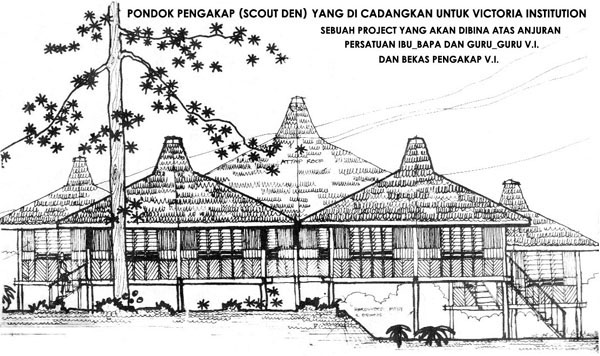
So in 1976, the V.I. Scouts finally had a permanent
structure in which to make their home. Initially, an elaborate multi-part
complex was planned to be built, costing $15,000.00 but the funds raised
were insufficient to cover that cost. So eventually, a modified double-storey
hexagonal mainly timber building was erected from the funds raised from
previous years. Costing $10,943.00, the construction of the building
had begun in 1975. The constructor was Mr Chan Soo Let while the architect
 was Mr Fong Ying Hong, an old Victorian who was a contemporary of Dato'
Dr Ronnie S. McCoy in the 1940's. Mr Fong was a renowned musician in
school (especially as the conductor of the school orchestra), a player
in the inaugural Laxamana Cup match in 1949 between the V.I. and the
Malay College of Kuala Kangsar, and later became a member on the Board
of Governors as a parent representative in the the 1970's. On 31 January
1976, the building was completed. It was officially opened by Dato
Murad b. Mohd Noor in conjunction with the V.I. Speech Day on 31 March,
1976.
was Mr Fong Ying Hong, an old Victorian who was a contemporary of Dato'
Dr Ronnie S. McCoy in the 1940's. Mr Fong was a renowned musician in
school (especially as the conductor of the school orchestra), a player
in the inaugural Laxamana Cup match in 1949 between the V.I. and the
Malay College of Kuala Kangsar, and later became a member on the Board
of Governors as a parent representative in the the 1970's. On 31 January
1976, the building was completed. It was officially opened by Dato
Murad b. Mohd Noor in conjunction with the V.I. Speech Day on 31 March,
1976.
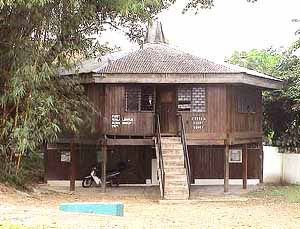
Located under the shade of the old bamboo patch, where the old car park used to be, the Den is a two-storey building. The ground floor is partitioned down the middle, with First KL occupying the left and Second KL owning the right side. The upper level is simply an open space but from the 1980's onwards, there was a row of cupboards running down the middle to divide up the space. So as one climbs the stairs and enters the door of the upper level of the Den, turning right would take him to the Second KL side while turning left would lead to the First KL side. Aligned along the hexagonal walls of this level are the patrol cupboards (one for each patrol; Boy Scouts and Seniors), and above the patrol cupboards are the patrol notice boards as well as posters on different types of Scoutcraft. And with all that, there is a table in the middle of what's left of each Group's area.
This upper level is called the "Common Room" because it is the place where the Scouts would hang out, whether to finish some school work or for a casual chat with some fellow Scouts. Also, many Scouts have spent many a day studying the finer aspects of Scoutcraft, either being guided by the PL or a Senior, or learning on his own with some guidance from old log books and Scout manuals. These log books, manuals and other general reading materials are kept in the cupboards that form the partition of the upper level; each Group having its own cupboards and materials of course. Thus, the Common Room is a kind of alternative library as well, besides being a storage area of patrol equipment.
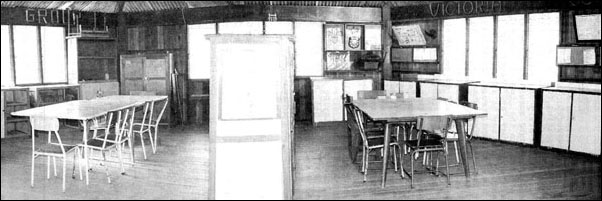
On the other hand, the rooms on the ground floor are reserved for the leaders of the Groups and are thus called "Scouters' Rooms", with each Group having one Scouters' Room. The Scouters' Room serves as the heart of the Group's administration. Troop property such as camping equipment (flysheets, hikers' tents, pressure lamps, pressure lamp kits, axes, parangs), Scoutcraft tools (compasses, games, balls, ropes, tackles, log books) and administration documents and historical items (trophies, souvenirs, scarves and badges, photographs) are kept in the Room. Most of these items are for borrowing and it is up to the initiative of the Scout to knock on the door and ask his Scouter.
In order to maintain the cleanliness of the Den,
patrols are scheduled for Den duty each day. Staying back after school
ends, the patrol sweeps, wipes, dusts and arranges the Common Room and
the area downstairs to ensure that the Den is spick and span. There is
also the Den Master, a post held by one of the Patrol Leaders. It
is his responsibility to check on how
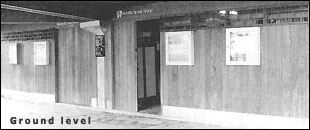 well the patrols had done their duty. As well, he has to make the
reading materials from the Group cupboards available and well-kept
for those who would like to refer to them. These traditions continue
to this day.
well the patrols had done their duty. As well, he has to make the
reading materials from the Group cupboards available and well-kept
for those who would like to refer to them. These traditions continue
to this day.
Indeed keeping the Den tidy is crucial not just because cleanliness should be an inherent attribute of a Scout, but also because the Den - both inside and around it - is the hive of activity for many boys daily. There would always be someone at the Den (except for a Sunday). Activity abounds: Scouters finishing some work in the Scouters' Room, Boy Scouts taking tests, Scouts working on Scout projects (Troop newsletters, models, log books) or experimenting with Scoutcraft (making a fire, repairing pressure lamps) or simply doing homework, the list goes on. Then there are the more "unorthodox" practices too, such as (in the 1980's) sneaking in at night via the holes in the school fence to just stay a night at the Den.
Thousands of V.I. Scouts have many a happy memory of their Scout Room or Den - be it in that corner of the wing near the swimming pool, or in the old Cadet Armoury, or in the old Jaga's Hut, or in the present Scout Den. Friendships have been built, knowledge gained and skills learned there - it is most justifiable to claim that indeed, the Room/ Den has been more than a hang-out ....it has been a second home to the V.I. Scouts.
 The V.I. Web Page
The V.I. Web PageLast update on 24 November 2003.
Pagekeeper: Chung Chee Min